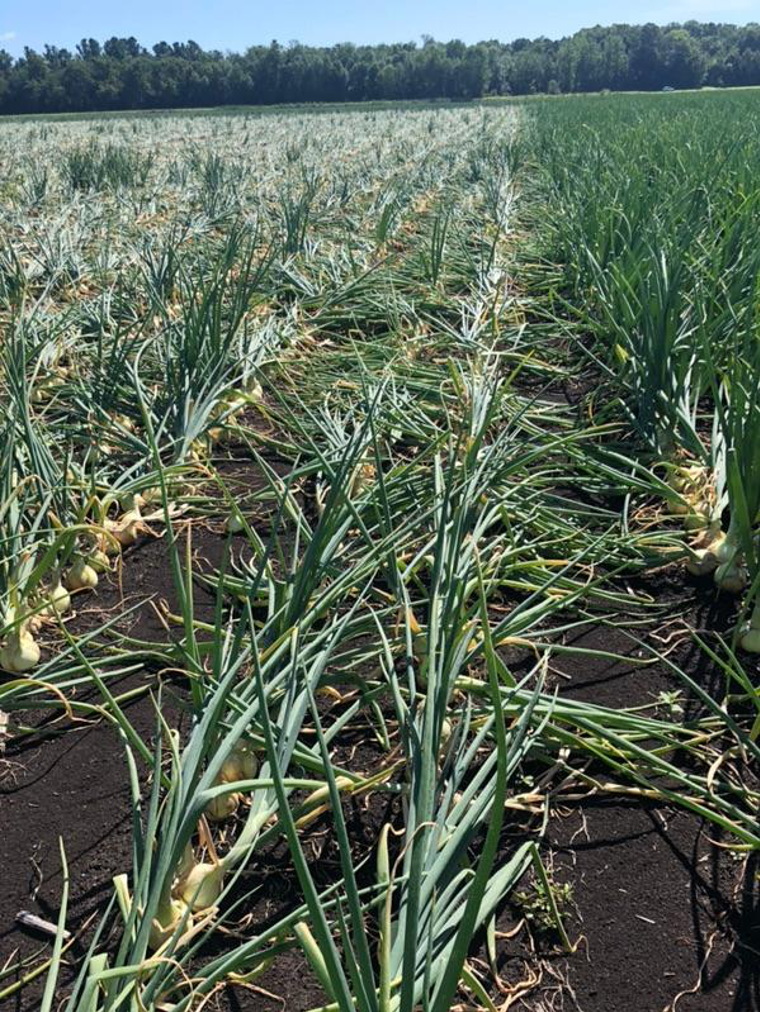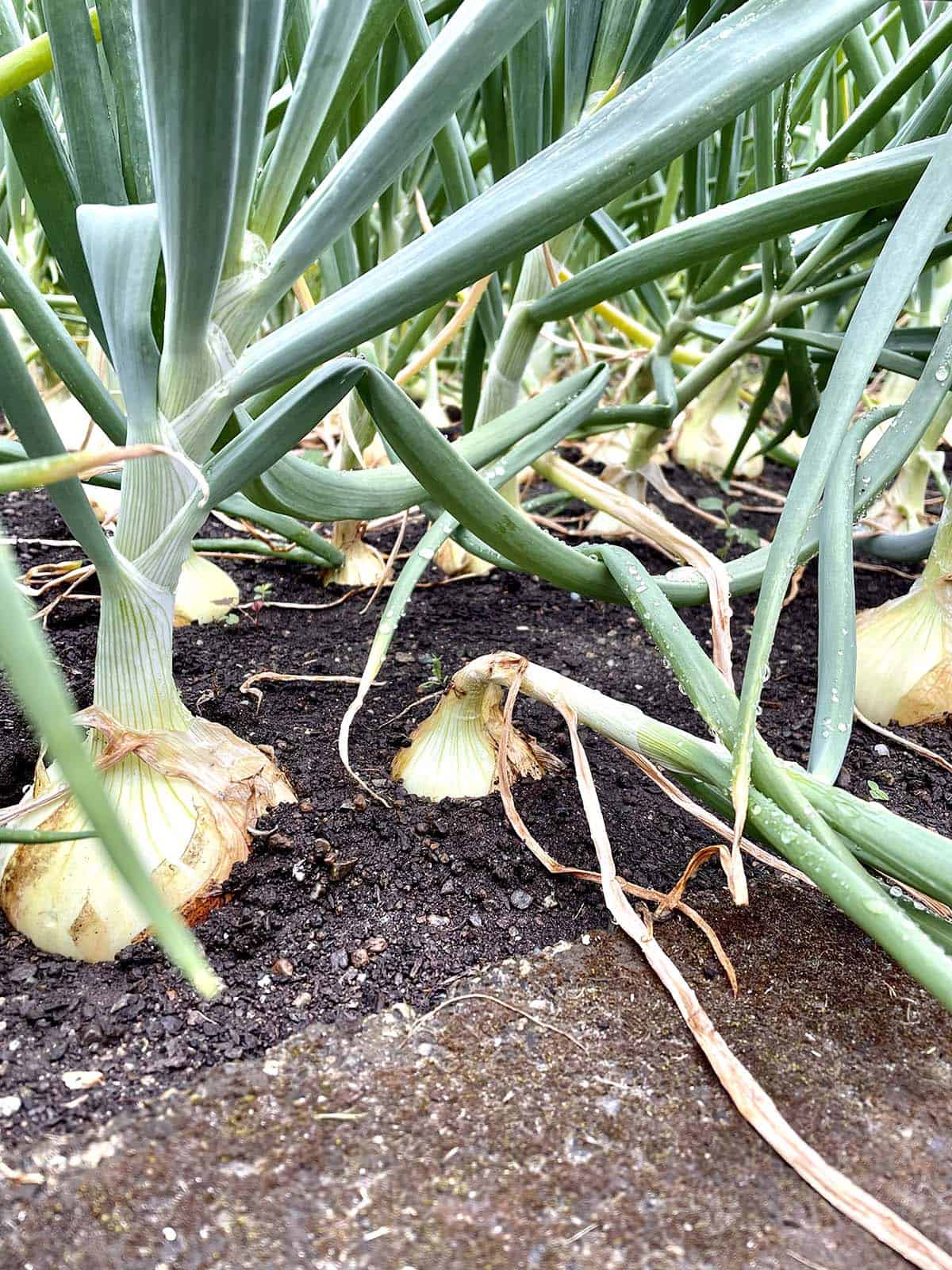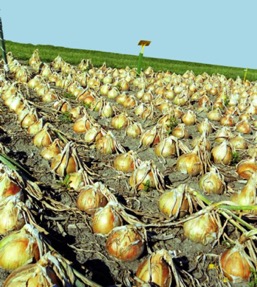Onions are ready to harvest when their tops fall over and turn yellow. The skin should feel dry and papery.
Harvesting onions at the right time ensures optimal flavor and storage potential. Onions typically grow in stages, and knowing when to pick them can make all the difference. A few signs indicate readiness, including the color of the leaves and the texture of the bulbs.
Gardeners should monitor their crop closely as the harvest time approaches. Waiting too long can lead to spoilage, while harvesting too early affects taste. This guide will help you identify the perfect moment to enjoy your homegrown onions at their best. Understanding these signs allows for a successful and rewarding harvest.

Credit: www.onionpatch.dixondalefarms.com
How to Know Onions are Ready to Harvest : Step by Step Guide
Introduction To Onion Harvesting
Onions grow best in full sun with well-drained soil. They require consistent moisture but not soggy conditions. Ideal temperatures range from 55°F to 75°F. Good air circulation helps prevent diseases.
Timing is crucial for harvesting onions. Yellow onions are ready when the tops start to fall over. Green onions can be harvested earlier. Check for bulb size to ensure they are mature.
| Onion Type | Harvest Indicators |
|---|---|
| Yellow Onions | Tops fall over, bulbs swell |
| Green Onions | Can be harvested anytime |
| Red Onions | Tops yellow and fall over |
Identifying Onion Types
Short-day onions grow best in regions with short summers. They need 10-12 hours of daylight. These onions usually mature in spring.
Long-day onions thrive in areas with long summer days. They require 14-16 hours of sunlight. These types are typically harvested in summer or fall.
| Onion Type | Best Conditions | Maturity Time |
|---|---|---|
| Short-Day | Short summers | Spring |
| Long-Day | Long summers | Summer/Fall |
Common onion cultivars include Yellow onions, Red onions, and White onions. Yellow onions are sweet and versatile. Red onions are great for salads. White onions have a sharper taste.
Growth Cycle Of Onions
The growth cycle of onions consists of several stages. First, germination occurs when seeds sprout. This usually takes about 7 to 10 days. Next, the seedlings grow and develop roots. This stage lasts for several weeks.
The bulbing stage follows. During this phase, the onion begins to form a bulb. Bulbing happens when the day length increases. Warm temperatures also help in this process. Onions need about 14 to 16 hours of light for good bulbing.
Finally, the maturation stage occurs. The tops of onions start to fall over. This indicates they are ready for harvesting. Checking the bulb size helps determine if they are ready.

Credit: www.theseasonalhomestead.com
Visual Clues For Harvest Readiness
To know if onions are ready to harvest, check the top foliage. Yellowing leaves are a great sign. When the tops fall over, it’s time to dig them up. Look for a few green leaves still standing, as this indicates good health.
Next, consider the bulb size and shape. Bulbs should be firm and rounded. They should feel heavy for their size. A good bulb will have a smooth skin. If the bulbs are too small or misshapen, they need more time in the ground.
Keep an eye on the weather. Dry conditions can help mature onions faster. Harvest them on a dry day to avoid rot. This way, you can enjoy your homegrown onions for a long time!
Testing Soil And Onion Firmness
Check the soil moisture to know if onions are ready. Use your fingers to feel the soil. It should be slightly damp but not soggy. If the soil is too dry, wait a few days before harvesting.
To test bulb firmness, gently squeeze the onion bulbs. They should feel firm and solid. Soft bulbs mean they are not ready. Wait a bit longer if they feel squishy. Harvest when they are nice and hard.
Timing The Harvest
Knowing the right timing for harvesting onions is crucial. Harvesting usually happens in late summer or early fall. The exact time depends on the onion variety and local climate.
Weather plays a big role in the readiness of onions. Warm, dry weather helps bulbs grow well. If it rains too much, bulbs may rot in the ground. Check the soil moisture before harvesting.
| Season | Best Harvest Time |
|---|---|
| Spring | Late June to Early July |
| Summer | August to Early September |
| Fall | Late September to October |
Harvesting Techniques
Harvesting onions requires the right techniques for the best results. Proper lifting methods are essential. Use a fork or spade to gently lift the onions from the soil. Avoid damaging the bulbs during this process.
Using the right tools makes harvesting easier. Here are some important tools:
| Tool | Purpose |
|---|---|
| Garden Fork | Loosens soil around onions |
| Spade | Helps lift onions from the ground |
| Gloves | Protects hands while harvesting |
| Basket | Holds harvested onions safely |
Ensure tools are clean and sharp for efficient harvesting. Proper care of tools extends their life.

Credit: dirtanddough.com
Post-harvest Handling
Curing onions is important for long-term storage. Start by laying the harvested onions in a warm, dry place. Make sure they get good air circulation. This helps them dry out and cure properly.
After about two weeks, the tops should be dry and crispy. This indicates they are ready for storage. Trim the roots and tops before storing.
Store cured onions in a cool, dark area. A well-ventilated container works best. Avoid plastic bags as they trap moisture. Proper storage helps onions last longer.
| Storage Method | Benefits |
|---|---|
| Cool, Dark Place | Prevents sprouting and decay |
| Mesh Bags | Promotes air circulation |
| Baskets | Easy access and visibility |
Common Mistakes To Avoid
Many people make the mistake of harvesting onions too early. This can lead to smaller bulbs. Wait until the tops fall over and dry out. Onions are usually ready when they feel firm.
Harvesting too late can also be a problem. Overripe onions can rot in the ground. Check the weather to avoid this issue.
Improper curing can ruin your onions. After harvest, place them in a warm, dry area. This helps them dry out properly.
Storage practices are important too. Store onions in a cool, dark place. Avoid plastic bags, as they trap moisture.
Troubleshooting Onion Harvest Issues
Onions can face many problems. Pests and diseases often affect their growth. Common pests include onion flies and thrips. Treat them with insecticidal soap or neem oil.
Diseases like downy mildew and onion rot can harm onions. Ensure good air circulation to prevent these issues. Crop rotation helps reduce disease risk.
Environmental stress can also impact onion health. Extreme temperatures can cause bolting. Keep the soil moist but not waterlogged. Use mulch to maintain soil temperature and moisture.
Frequently Asked Questions
How Can I Tell If Onions Are Ready?
Onions are ready to harvest when their tops start to yellow and fall over. Look for a bulb that is firm and has reached its full size. The skin should be papery and dry. Timing varies, but typically, onions are ready 100 to 175 days after planting.
What Do The Leaves Indicate About Onion Readiness?
The leaves of an onion plant signal its readiness. When the green tops begin to wilt and fall over, it’s time to harvest. Healthy leaves indicate that the onion is still growing. However, if they flop over, the onion has stopped growing and is ready for harvest.
How Long Do Onions Take To Mature?
Onions typically take between 90 to 180 days to mature, depending on the variety. Factors like soil quality, weather, and care can affect this timeline. Early varieties mature faster, while storage onions take longer. Always check the bulb size and leaf condition for the best harvest time.
Can I Harvest Onions Too Early?
Harvesting onions too early can lead to smaller bulbs. If you pick them before the tops fall over, they may not reach their full size. It’s essential to wait for the leaves to yellow and flop down. This ensures you get a more substantial, flavorful onion.
Conclusion
Harvesting onions at the right time ensures the best flavor and storage potential. Watch for yellowing tops and a firm bulb. Timing is key to maximize your yield. With these tips, you’ll enjoy a successful onion harvest. Happy gardening, and may your onion crop be plentiful and delicious!

